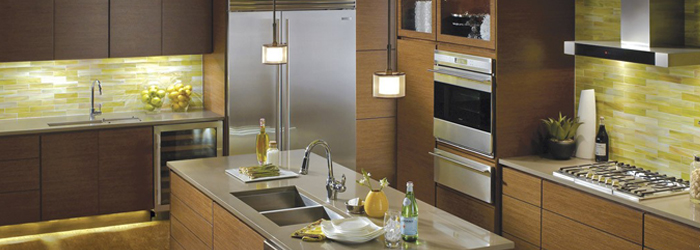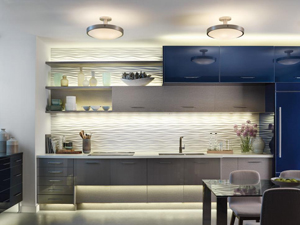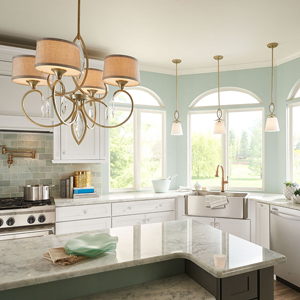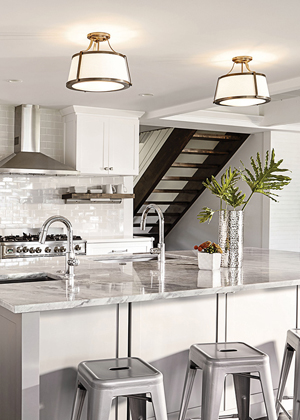Throw New Light on Your Life
 19 October 2016
19 October 2016 

Nothing dates a house like old lighting fixtures and old-style light bulbs.
So what are some of the trends in the lighting marketplace? And are these do-it-yourself lighting projects or do you always need an expert to help on your job?
 One easy way to update lighting is simple and not too much of an investment: Change your light bulbs. The LED revolution is continuing to grow because LEDs or light emitting diodes are smaller, more energy efficient, brighter and more long-lasting than halogen, incandescent and CFL bulbs. LEDs don’t get as hot as other options and don’t add a lot of heat to your house in summer. They are more expensive, but prices have been dropping dramatically for years and some utilities in Arizona offer instant discounts on LEDs.
One easy way to update lighting is simple and not too much of an investment: Change your light bulbs. The LED revolution is continuing to grow because LEDs or light emitting diodes are smaller, more energy efficient, brighter and more long-lasting than halogen, incandescent and CFL bulbs. LEDs don’t get as hot as other options and don’t add a lot of heat to your house in summer. They are more expensive, but prices have been dropping dramatically for years and some utilities in Arizona offer instant discounts on LEDs.
LEDs generally work well as replacement bulbs in can lights. They can be heavier and have funny ridges that can be a problem in some fixtures. But their shapes and appearance are improving, says Robin Childers of Statewide Lighting in Scottsdale. Increasingly attractive LEDs are available for almost every light fixture, including chandeliers.
 If you’re using them in lamps, look for omni-directional LEDs that create a more enveloping light than the single-directional LEDs that emit light only from the top half.
If you’re using them in lamps, look for omni-directional LEDs that create a more enveloping light than the single-directional LEDs that emit light only from the top half.
If you’re buying them for use with a dimming switch, buy bulbs that are compatible with traditional switches or replace your current dimming switch with a leading-edge electronic dimmer.
Changing light bulbs doesn’t mean hiring an electrician, of course. But what about doing something more dramatic?
As a general rule: If you relocate a fixture or add a new location for lighting or a ceiling fan, you need to hire a licensed electrician. If you’re replacing like-for-like, one fixture for another similar fixture in the same location, you can do the job yourself.
Some popular examples:
- If you hang multiple pendants over the dining room table or kitchen island instead of a single chandelier, you may need an electrician to install more wiring to serve the additional hanging lights. But if you’re just replacing the chandelier, you can do it yourself.
- If you’re getting rid of floor lamps and adding sconces to the walls, it requires changes in the wiring and you probably need an electrician. For a job like this, you have to add a wall switch as well to control the lights.
 If you replace a ceiling light fixture with one that has a fan attached, you need an electrician to install a code-approved box inside the ceiling to support the fan.
If you replace a ceiling light fixture with one that has a fan attached, you need an electrician to install a code-approved box inside the ceiling to support the fan.- Even if you’re replacing a ceiling fan with a light kit with a similar fixture, you might need a helper because of the weight of the fixtures involved in the change.
- One hot lighting trend is installing strips of mini-LEDs under kitchen or bathroom cabinets, along the kick plates at the bottom of cabinets, or even inside dark cabinets or drawers. Some homeowners also mount them on staircases so that each step gets lighting at night for safety’s sake. You can easily staple or tape these lights into place. You can use them to replace old-fashioned fluorescent lights under your cabinets. If there is already an electrical connection inside or under a cabinet or an outlet available, this can become a DIY project. The lighting kits generally have good instructions. But if you’re not experienced with electricity, you should hire an electrician.
- If you want to change a switch plate for a light, you can do it yourself, but if you want to change the switch itself to a dimmer, you want an electrician.
Of course, the No. 1 rule for working with electricity is to be sure that before you start a job, you turn off the circuit breaker for the area of the house where you are making electrical changes.
###
Photo Credits:
RELATED CONTENT:
- DIY Q&A: What's the difference between Watts and Lumens?
- Article: What's hot in bathrooms?
- Blog: Must-do fixes in your aging home.
- Trend: Are open kitchens closing up again?
- Find trusted Arizona contractor and home improvement service providers
Print this page
recent post
- Duck, Duck, Duct! How Often Should Ductwork Be Cleaned?
- Vinyl vs. Fiberglass Windows: Which Is The Better Choice Of Replacement Window?
- We May Be The Grand Canyon State, But The Rocky Mountains Are Important For Arizona
- Welcome to Arizona! Things A Newbie to Arizona Should Know
- The Pros & Cons of Buying A Flipped House
- Getting In On The Ground Floor
- Why It’s More Critical Than Ever To Get Your AC Serviced Before Summer
- The Reality of Remodeling
- What To Look For When Comparing Your Roofing Quotes
- What To Expect When Buying New Windows & Doors
